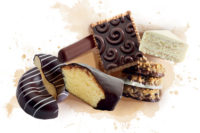There are plenty of challenges today for manufacturers using compound coatings as there are for those using chocolate.
For starters, let’s begin with the demand for cleaner labels. As Katy Cole, technical service manager for Cargill Cocoa & Chocolate points out; it’s all about the consumer.
“Today’s consumers are seeking more choice and transparency in their food, and compound coatings are certainly not immune to this trend. Consumers want to recognize the ingredients, understand what purpose they serve in a product and even know where the ingredients come from. Growing demand for non-GMO and organic products is a reflection of this overall trend in consumer purchase decisions.”
As a result, this had led to customers requesting natural flavors, where artificial flavors might previously have been accepted, she says.
“In some cases, that can present trade-offs,” Cole explains. “There’s currently a shortage of vanilla, which is driving up prices. Companies have to determine what is most important to their customers: clean label or cost. Thus far, when it comes to natural vanilla vs. synthetic vanillin, the clean-label option seems to be winning.”
The clean-label trend also extends to companies opting for natural, non-synthetic colors and BST-free milk ingredients, she says.
“Even lecithins are drawing some scrutiny,” Cole points out. “We’ve had customers replace soy lecithin with a non-Big 8 allergen such as sunflower or canola lecithin, or in some cases, avoid lecithin altogether.
“We’re also finding customers are asking more detailed questions about the origins of our ingredients. Interest in RSPO-certified palm oil and certified cocoa is on the rise, as customers strive to source products with sustainable ingredients.”
Alex Funk, R&D scientist – product development, for the Blommer Chocolate Co., concurs. There’s certainly been “a big shift towards cleaner labels,” he says. “Quite a few of our customers are switching to versions of their coatings that contain natural flavors and naturally sourced colors. With so many large CPGs pledging to get rid of artificial flavors and colors, it is trickling down to other companies that want to promote the same message.”
Interestingly, in this quest for cleaner labels, compound coatings have found a new role, one of being an ideal carrier for “better-for-you” ingredients and actives.
Laura Bergan, director of innovation, marketing, for Barry Callebaut, says that compound coatings can be great vehicles for delivering healthy ingredients for sweet products.
“There are two different approaches to do this,” she says. “One is the natural goodness or health benefits that a chocolate or compound can deliver. For example, using coconut sugar versus a standard beet or cane sugar can deliver a healthier and wholesome product.
“The second approach is by adding a nutrient to the chocolate or compound coating, such as adding protein or fiber, enriching it and adding incremental grams of protein or fiber to a food manufacturer’s product,” Bergen adds. Another example is reducing the sugar level and offering a healthier option. This latter approach can help a food company that is developing products within the health/nutrition area such as confections, healthier snacks or the snack/nutrition bar category.
And here is where compound coatings excel.
“Compound coatings can be a carrier for a wide range of more healthful ingredients, including fiber and protein,” Cole notes. “Try to pack more good-for-you ingredients into a nutritional bar or cookie formula, and they can have a negative impact on the final product, affecting texture, taste and more. Put those same ingredients in a compound coating, and you can deliver all of the nutritional benefits, without altering the core product.”
Another area where compounds are growing is in the functional coating space, Funk adds.
“Protein is trending in most food categories, and compounds are no different,” he says. “There has been an increased demand from bar companies to provide high-protein coatings that deliver function and taste, along with a clean label. Whereas before protein coatings were perceived to contain a lot of artificial and unwanted ingredients, now they are at the forefront of innovation and responding to consumers’ wishes for clean label protein products.”
Cole couldn’t agree more. However, where soy and whey proteins once ruled, the ingredient mix has changed, with vegetable proteins like pea coming into play. Companies are also enhancing their compound coatings with a wide range of fibers, including soluble chicory root fibers.
“As an added benefit, enhancing coatings with protein or fiber can help with sugar and calorie reduction, as they take the place of some of the sugar in the coating,” Cole points out. “Not surprisingly, interest in sugar reduction is growing, driven by the upcoming addition of ‘added sugar’ to the Nutrition Facts panel along with general weight management concerns. Flavor can be a challenge with some protein and fiber sources. Fortunately, cocoa confectionery coatings do a wonderful job of masking off flavors.”
One segment that’s definitely taking advantage of the versatility associated with compound coatings is the snack and energy bar category. Funk, in fact, predicts that, in addition to protein, demand for other functional compound coatings will also increase.
“There is limited space in a bar formulation to fit functional ingredients, which is why a compound coating is a great medium for adding protein, vitamins and other health-promoting ingredients,” he explains. “This can add challenges in learning how to process compounds efficiently with the addition of new ingredients, but overcoming these challenges leads to great opportunities in an expanding market segment.”
And what about the recent interest in more premium chocolates? Any impact on compound coatings?
“There has been an increase in preference for darker, richer cocoa profiles with compound coatings that provide an eating experience closer to that of chocolate,” Funk admits. “This allows companies to use a more indulgent-tasting product while maintaining the functionality of a compound coating.”
Moreover, as Cole points out, consumers continue to be drawn to indulgent tastes. “Caramels, cappuccinos and coffee flavors are among the most popular with our customers,” she says. “That desire for decadence plays out in textural components, too. Especially within the inclusion space, consumers are drawn to products with finer particle size and higher cocoa butter levels, which deliver a smoother, melt-in-your-mouth sensation, along with larger, more indulgent chocolate pieces.”
Zachary Freed, AAK’s Customer Innovation Application Specialist sums it up best: “The confectionery industry continues to evolve as consumers’ tastes and preferences change. Nutritional bars made with great tasting compound coatings, packed full of protein and fiber, allow those who live an active and busy lifestyle to get their energy on the run. Labels are cleaning up with the use of alternative ingredients: soy lecithin instead of the emulsifier PGPR, stevia and monk fruit extract instead of artificial sweeteners, and vegetable proteins like pea and rice take the place of traditional dairy powders. The consumer can now enjoy their indulgences with these guilt-free alternatives. Compound coatings are the perfect vehicle to deliver better-for-you ingredients while maintaining the number one drivers of repeat purchase — flavor and texture.”








